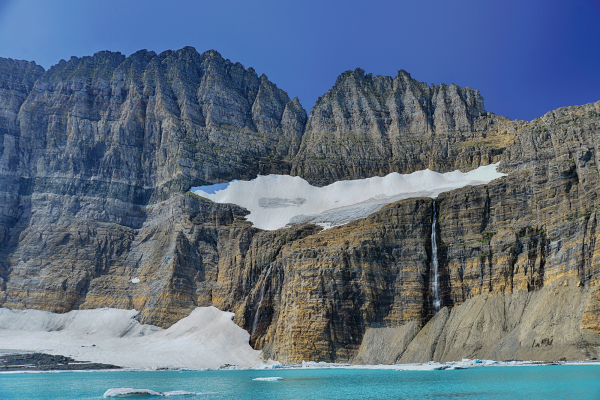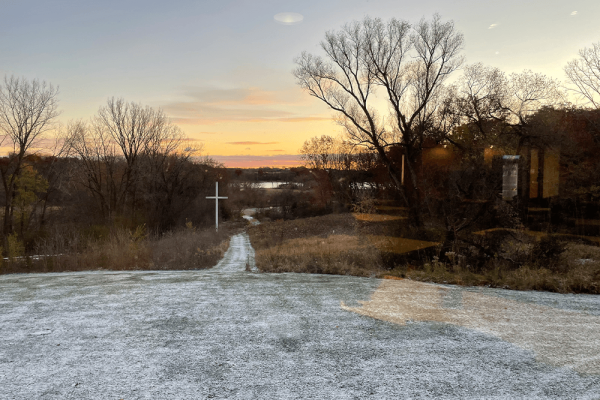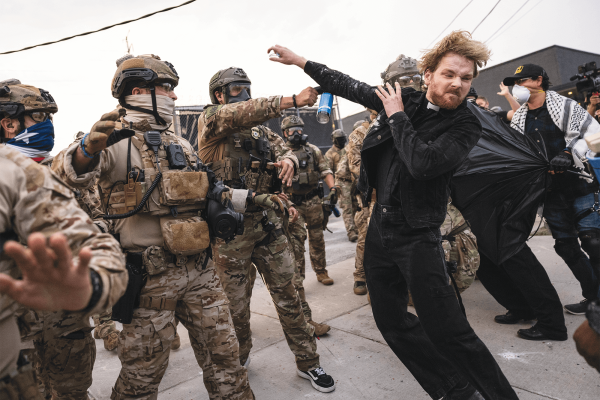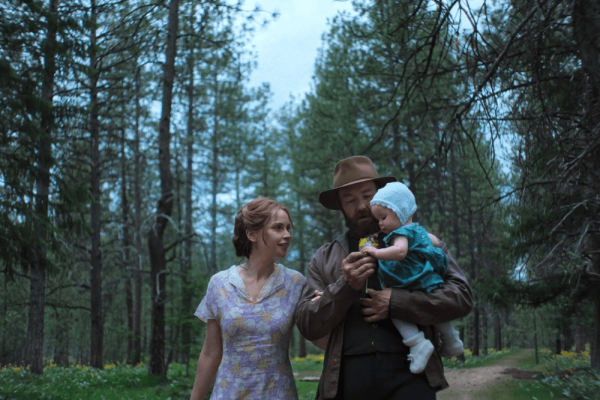I KNOW WHAT it’s like to be baptized in the meltwater of a dying glacier. It feels like a plunge into all the emotions of living in our climate-changed world: joy, dread, awe, fear, love.
In August, a few of my college friends and I took a trip, something of a pilgrimage, to Glacier National Park in Montana. We wanted to visit the glaciers that are projected to die off in the coming decades. The Kootenai people call this place Ya·qawiswitxuki, “the place where there is a lot of ice.” It is a place burdened with names that it will hold on to even after the glaciers and ice disappear.
The geology of the park is like a cake cut open to show layers of sandstone, shale, and limestone — a portal into deep time. About 100 million years ago, in an event called the Sevier Orogeny, the mountains in Glacier formed as the forces of colliding tectonic plates thrust two billion years’ worth of sedimentary rock upward. Across 100,000-year cycles, glaciers formed and retreated, slowly whittling away at the rock and carving out dramatic valleys, moraines, arêtes and horns, cirques and tarns. During a simple four-hour hike, we walked through billions of years of sedimentation.
Walking through such a place makes this moment in history seem both insignificant and deeply important. Thousands of feet of layered sediment formed organically, with nearly no human influence, but the small sliver at the top will be markedly human. This Anthropocene layer in the geologic cake holds markers of nuclear bombs, cow manure, and a lot of plastic. It holds the most dramatic increase in carbon concentration and the accompanying increase in temperature. It holds the extinction of hundreds of creatures, which may soon include the western glacier stonefly and meltwater lednian stonefly, who require ice-cold clear streams to survive.
This layer is also the moment, a blink of an eye in geologic time, when the mighty glaciers disappear. It is estimated that by 2100, two-thirds of the world’s glaciers will be killed. The reality is more devastating in the eponymous national park, where all the glaciers are expected to be gone by the end of this century. I can’t predict all the impacts the park will feel over the next 75 years, but I imagine that the numerous hikers currently making pilgrimages to the glaciers will instead walk in funeral processions to plaques, like the one marking the death of the Okjökull Glacier in Iceland.
The glaciers I met started forming around 6,000 years ago and reached their peak in the “Little Ice Age” of the 19th century. Of the 26 surviving named glaciers in the park (down from 35 in 1966 and around 80 in 1910), Grinnell Glacier is the most well-known, largely thanks to its accessibility to hikers.
When my company arrived at the banks of the Grinnell tarn, the glacially carved lake filled with meltwater, I felt an immediate desire to jump in. The waters were a delicious milky blue, inviting us in to be fed and nourished.
So, we took the plunge. To be frank, there was nothing initially sacred about our ritual. It was a combination of boyish glee and blatant disregard for the physiological consequences of jumping into the 40-degree water.
But when I dipped into the water for a second time, I stayed as long as I could physically handle it — no more than 30 seconds — to experience the holy water.
I was baptized by Grinnell Glacier. The ancient glacial priest held me and lowered me into the waters of our dying world. I surfaced gasping for air.
This wasn’t my first baptism. I was baptized as a 5-year-old, dunked in the small font at First Southern Baptist Church in Topeka, Kan. Baptism was a testimony that my soul had been saved, that I was sealed for the kingdom. It was an insurance policy, guaranteeing that I was headed down the narrow road in the afterlife.
In the Bible, baptism is a creation-soaked sacrament. In the account of Jesus’ baptism in the Gospel of Matthew, the divine is woven in with the nonhuman. The baptism itself happens in the middle of the Jordan River, with onlookers on shore and in the water. Surely as John and Jesus stood in the river, blue tilapia (known in the region as Jordan St. Peter’s fish) swam by their legs while mosquitoes buzzed about their faces. Even God participates in the ecology of the moment, descending from heaven “like a dove.”
Water is both a witness and a participant in this ritual of new life.
According to the Didache, an early Christian teaching manuscript, baptism ought to occur in cold, “living” waters. There is something particularly holy about swimming in the living waters of creation, rather than those of the indoor font. The drama of creation plays out in these waters — life, death, and the evolution of creatures. Water is too powerful for us to contain. This is another reality climate change has revealed to us: As floods fill our houses, we are reminded that we are not at all separate from the forces of the nonhuman world.
My Grinnell baptism was a rebirth into my love for the world. It wasn’t a preparation for the afterlife; it was a reacquaintance with the world where I currently live. For most of the last decade, I have been so deeply focused on saving the future of our climate-changed world that I ignore the parts of creation that are presently dying. Sometimes it is easier to wall myself off from the grief. But as I surfaced from the meltwater, I gasped for something more. I gasped to breathe in all the air in our hurting world and hold it inside myself. I gasped to open myself, my porous body, to the grief incarnate in those frigid waters. I gasped to open myself to the possibility that these frigid waters might hold more than death and grief. These holy waters might nourish the wildflowers on the way down the mountains, fill a parched hiker’s water bottle, and enter the everlasting water cycle, eventually ascending to the clouds and coming back down to bring life to a dry and weary land.
For most of my life, etched in my brain from years of Bible memorization, my favorite verse has been Galatians 2:20: “I have been crucified with Christ and I no longer live, but Christ lives in me.” Now I know what it’s like to let Christ, in whom all came to be and in whom all things hold together, live in me through the frigid meltwater. To be one with the earth is to be one with Christ. It is to come to a somatic understanding that the powers and principalities of our world will crucify that which is holy. But crucifixion is not the end.

Got something to say about what you're reading? We value your feedback!







